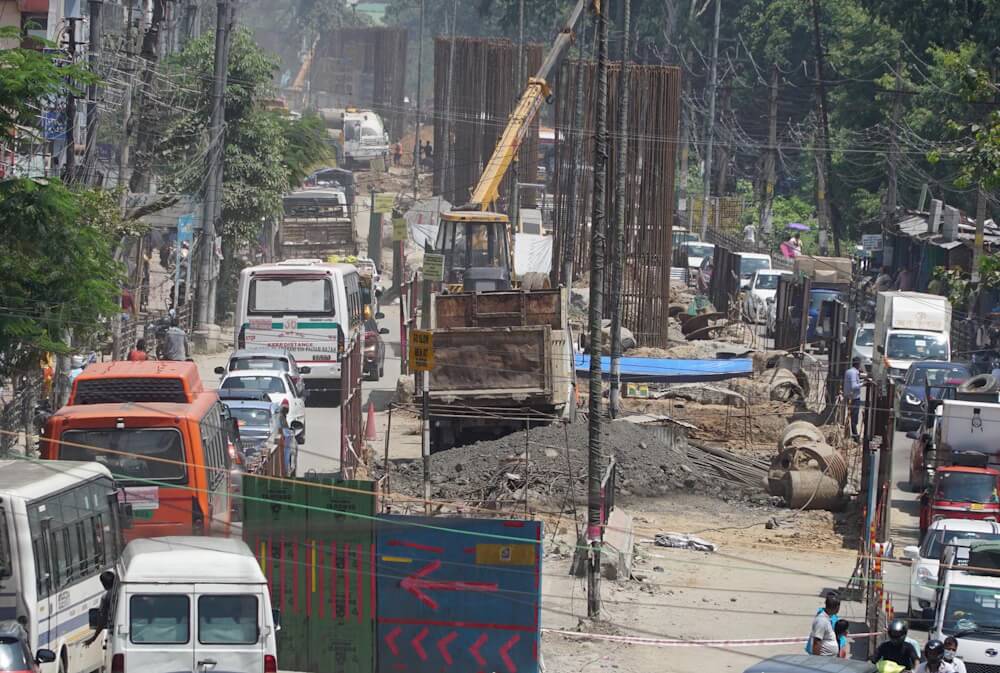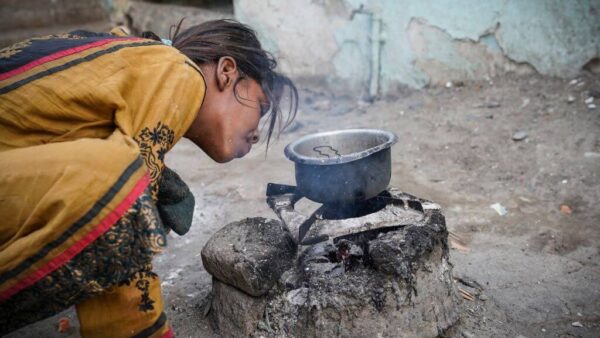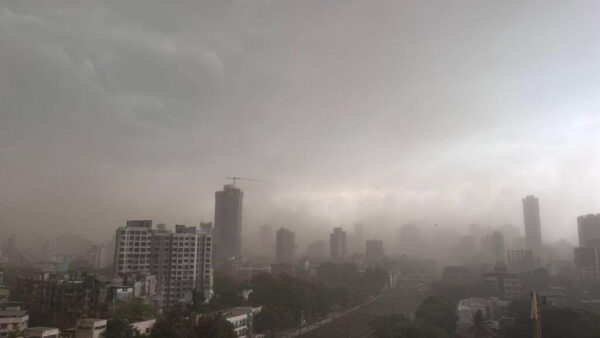Guwahati, the largest city in northeast India, has been experiencing intense heat, recording a season-high temperature of 37.8 degrees Celsius on April 7 this year.[1] In 2023, the city saw record-breaking high temperatures[2] in June and September. Clearly, climate change has come to settle in the hills here.
The city has also been facing the Urban Heat Island (UHI) effect. This happens when heavily-urbanised and concretised areas register higher temperatures than the surrounding suburban or non-urbanised areas, primarily due to surface and atmospheric modifications from choice of building materials, combined with decreasing green cover. The incremental reduction in green cover has adverse effects on air quality too. This translates to a significant rise in air temperature, leading to heightened discomfort for people.
Mahaveer Saha, a carter-cum-loader in the growing city for 40 years, recounts his observations of its evolving urban landscape. “Back in the years, Guwahati was a far more pleasant place to work than back home in Bihar. The weather was agreeable, with relatively mild summers. After a strenuous morning, we would gather under a tree in the afternoon to relax, engage in conversations, and take a nap. The sprawling peepal trees at Athgaon (a bustling market area), was a meeting point for cart pullers and loaders awaiting work opportunities. Nowadays, getting a bit of shade to sit, whether in a shop corner or a less-than-ideal alley, is a stroke of luck.”
For thousands of outdoor workers like Saha, the escalating heat is a concern they cannot afford to dwell on. In fact, the struggles persist for every person without the luxury of being in an air-conditioned room when temperatures rise. Simultaneously, the more privileged individuals face higher electricity costs due to the intensified reliance on air conditioning.[3]

A 2014 study conducted by Apurba Kumar Das and Juri Borbora[4] revealed the existence of a summer UHI intensity in Guwahati – the core city areas were up to 2.12 degrees Celsius warmer in the day and 2.29 degrees Celsius warmer at night than the outskirts. The replacement of natural vegetation areas with dry impervious surfaces, the use of building materials like concrete rooftops and bitumen roads which have high heat capacity and low surface reflectivity, and increased heat emission largely from vehicles and air-conditioners contribute to the intensification of the UHI effect.
The Guwahati Metropolitan Area (GMA) comprises around 275 square kilometres. There has been a reduction in dense forests by 44.4 percent, moderately dense forests by 43.4 percent, open forest by 17.5 percent, and scrub by 4.8 percent, according to Chandra Kant Pawe and Anup Saikia’s[5] analysis of Landsat images from 1976 to 2018. Simultaneously, non-forested areas increased twelve-fold – by 1,475 hectares during the same period.
Lackadaisical implementation
There is no dearth of policies and schemes to enhance the urban green cover. The explicit reference was in the National Action Plan on Climate Change (NAPCC). As part of the plan, the Union Government released the National Mission for Sustainable Habitat (NMSH)[6] in 2010, and revised it in 2021 to align with India’s commitment to the Paris Agreement.
It calls for “the promotion of maintaining green cover using an ecological approach, specifically focusing on native tree species and sustaining urban biodiversity as carbon sequestration and regulation of microclimate,” ensuring 10-12 percent of the city’s developed area under recreation space, including the green and blue infrastructure. It proposes the preparation and implementation of a Climate Action Plan (mitigation and adaptation) for cities with a million-plus population, integrated with the Master Plan, Local Areas Plans, and Town Planning Schemes.
Under NMSH, the Atal Mission for Rejuvenation and Urban Transformation (AMRUT) and the Smart Cities Mission (SCM) were initiated by the Ministry of Urban and Housing Affairs. Each had budgets to conserve and encourage urban green cover, among other aspects. Guwahati, with a population of over a million, was selected as one of the 500 AMRUT cities and 100 Smart Cities.[7]
However, the city started seeing a decline in its urban greenery. It does not have a dedicated project under these programmes to preserve or enhance urban greenery. There is no clarity on how the ongoing Brahmaputra Riverfront Development project, spanning 6 kilometres, will augment the green. The city has 40 large and small parks managed by the Guwahati Metropolitan Development Authority (GMDA), encompassing a combined area of over 16 hectares. Nine of these have been recently redeveloped – but with more concretised areas than before.

Photo: Surajit Sharma
Additionally, under AMRUT, the Guwahati Municipal Corporation(GMC) has outlined the redevelopment of five of the parks in its annual plan.[8] However, on-site surveys show insufficient plantation efforts with a focus on ornamental shrubs. Also, the plantations prioritise aesthetic appeal over ecological attributes and advantages. The detailed report typically outlines preferred species of trees but this is often altered by architects, engineers, or landscaping agencies without seeking recommendations from the departments concerned. The same state government, as part of Green Highways initiative, has prioritised tree transplantation over tree cutting, with guidelines.
Landscape architect Rajib Sarma, who oversees several landscaping projects, said, “Guidelines should be established for other agencies involved in parks and avenue creation, and urban development projects within the city. The focus should be on planting crepe myrtle (ajar), gulmohar, copper pod, calliandra (spiked powderpuff), neem, and other substantial species. These large trees not only enhance the aesthetic appeal of the area but also contribute by providing shade and environmental benefits.”
The centre’s Green India Mission (2014)[9] and the Nagar Van Yojana (2020)[10] also promote the augmentation of urban green spaces but, till 2022-23, Assam had not availed funds under the GIM.[11] Under the Nagar Van Yojana, the state secured approval for three projects, including one of 39 hectares located in Pamohi, Guwahati.
Although the Assam Government released its introductory Green Budget for 2023-24, it fell short of addressing dedicated action to preserve and expand urban forests. Within Guwahati, the budget confines its scope to creating green cover solely on the Silsako Beel rejuvenation project. The main budget for 2024-25 is silent on urban green cover although Rs. 40 crore has been allocated for the plantation of 3 crore saplings statewide. At the time of writing this, the Green Budget for 2024-25 has not been released. A consolation here is that the GMDA will be transforming the Borbari hill into a forest by planting 1,400 saplings across an area of four square kilometres.
Guwahati’s lungs
The funding of both the GIM and the Nagar Van schemes are integrated with the Compensatory Afforestation Fund Management and Planning Authority (CAMPA) by a relevant law. CAMPA is designed to encourage afforestation and regeneration, to offset the forest land diversion to non-forest purposes such as development and industrial projects. However, the funds are not used only for compensatory afforestation but also for other initiatives such as the development of forest and wildlife-related infrastructure, wildlife management, acquisition of amenities for staff, administrative expenses, and staff salaries.
Guwahati is surrounded by 18 hills, eight reserve forests (South Kalapahar, Fatasil, Jalukbari, Gotanagar, Hengrabari, Sarania Hill, Garbhanga, Rani), and two wildlife sanctuaries (Deeporbeel and Amchang). The reserve forests under the Kamrup East Forest Division function as the primary green lungs of the city or a reservoir for carbon sequestration.
Official records show that 979.8 hectares have been encroached upon and approximately 149 hectares diverted for non-forestry purposes like construction of railway track, national highway, water reservoir, stone mining, among others. In 2022, the state cabinet mandated the plantation of 10 trees against every tree cut outside the forest area for development projects. Around 863 trees were felled in 2023 alone in Guwahati; it is unclear if the compensatory plantation should be within the city limits.

Photo: Surajit Sharma
Initiatives sans mandate and punitive action
Though the Guwahati Master Plan 2025[12] has a positive legal framework, with hills and large water bodies designated as eco-sensitive zones to safeguard them from development, the effectiveness of this plan faces challenges, particularly in dealing with encroachment issues within the specified zones.[13]
“While the NAPCC and its affiliated schemes (GIM & NMSH) advocate for the protection and augmentation of urban green cover, these remain more, as missions, and guidelines. Notably, there is no penalty stipulated for failing to conserve or expand green cover, as outlined by these missions,” observed Deepti Talpade, Program Lead, Urban Development at WRI India.
According to Dr Pranab J Patar, environment and sustainability expert, and CEO of Delhi-based Global Foundation, there are various policy frameworks to ensure minimum green cover in cities, such as Urban and Regional Development Plans Formulation and Implementation (URDPFI) Guidelines, 2014, which recommends minimum 12-18 percent greenery. “It translates into 10-12 square metres of per capita green space in urban areas and 1.2-1.4 hectares of green space per 1,000 population. Yet, we still have so much confusion around the issues of greenery. These national guidelines are hardly followed during on-ground implementation, let alone international benchmarks such as WHO standards which recommend as much as 50 square metres per person,” he said.
“Although schemes like Nagar Van Yojana encourage increasing green cover in cities, they lack references about how these schemes can be executed at the state level. A significant deterrent to the preservation of urban green spaces is, ironically, the CAMPA which allows compensation for the green cover loss to cater to development projects,” added Patar.

Photo: Surajit Sharma
In Guwahati, there is no thrust or mandate from either the Department of Science, Technology and Climate Change or the Department of Housing and Urban Affairs to ensure effective augmentation of green cover despite schemes funded by the central government. Senior officials of both departments denied having responsibility for the plantation.
Experts like Patar suggest the Miyawaki forest technique to create dense forests in limited urban spaces in a short period of time. Official endorsement is making this popular in re-greening campaigns. However, the issue is deeper than this. While policies and schemes emphasise “forest cover,’ it is a concept distinct from “urban greenery or urban forests”.
What is needed is the official will and policies to comprehensively address all aspects of urban green in the broader context of climate strategies in cities. Equally, it is important to address the growing conflict between development and urban green spaces in cities, including in the once-verdant cities like Guwahati.
The 2025 Master Plan only focused on preserving existing green cover, a goal that appears to have fallen short of expectations. However, it did not include any dedicated land allocation or zones for plantation purposes. The next city Master Plan for 2045 is in the planning stage; there is an opportunity to incorporate dedicated projects and land allocation for this crucial cause.
Then, there are central government schemes which states and cities should proactively engage with. Simultaneously, states should explore avenues within their own budgets to focus on the Green Budget or city-specific Climate Action Plans. It is critical, at this stage, to not only conserve Guwahati’s green cover but also augment it as a measure against heat waves in the future.
Barasha Das is an independent journalist based out of Guwahati, Assam. She reports on environment and Climate Change — causes, adverse impacts, and policies to combat climate disasters. She has extensively covered every aspect of reporting on ‘city’. She is also associated as a Research Writer with OnePointFive Tribe, a platform working for a Net-Zero Carbon Future.
Harish Borah is a subject expert in cost/carbon studies within the building industry. He is the Principal ‘Carbon’ Expert for ADW Developments (UK); member of GRIHA’s ‘Technical Advisor Committee’, and Founder of OnePointFive Tribe. His work portfolio is spread across the UK/EU, the Middle East, and India. He has also been named among India’s top 25 leading minds in sustainability by the Economic Times.
This is the third part of a series supported by the QoC-CANSA Fellowship to report on Climate Change and cities in four nations of South Asia. The first essay details how the rapid urbanisation in Assam’s capital Guwahati has increased emissions. Their second essay delves into the human-induced factors that have contributed to the severe floods in Guwahati, Assam, in the past few years.
Cover photo: Flyover construction in Guwahati. Credit: Surajit Sharma




